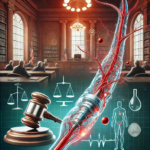Suboxone is a prescription medication used primarily in the treatment of opioid addiction. It combines two active ingredients, buprenorphine and naloxone, which work together to reduce opioid withdrawal symptoms and the urge to use opioids. Buprenorphine is a partial opioid agonist, meaning it activates opioid receptors in the brain but to a much lesser extent than full agonists like heroin or prescription painkillers. Naloxone is an opioid antagonist, which blocks the effects of opioids. This combination makes Suboxone effective in helping individuals manage their addiction and work toward recovery.
For those struggling with opioid addiction, Suboxone can be a lifeline. It provides a way to manage opioid withdrawal symptoms and reduce cravings, making it easier to focus on recovery. However, the use of Suboxone is not without controversy and legal implications. Patients and healthcare providers must navigate a complex landscape of regulations, potential side effects, and the risk of misuse or dependency on the medication itself.
If you or a loved one is dealing with opioid addiction, understanding Suboxone and its implications is crucial. At Mass Tort America, we are dedicated to providing the necessary information and legal support to help you navigate this challenging journey. Our team of experienced professionals is here to assist with any legal issues related to Suboxone and ensure you receive the support you need.
How Suboxone Works
Suboxone is designed to help individuals with opioid use disorder reduce or quit their use of heroin or other opiates, such as pain relievers like morphine. Buprenorphine, one of the active ingredients, binds to the same opioid receptors in the brain as other opioids but does so less intensely. This action helps to alleviate withdrawal symptoms and cravings without producing the same “high” as other opioids. As a result, it is easier for individuals to transition away from more harmful substances.
Suboxone contains naloxone in its formula. These drugs are contained in Suboxone for the prevention of misuse. Due to the substance, Suboxone may cause withdrawal symptoms. Naloxone acts as an opioid antagonist which stops its use. Suboxone may inhibit your ability to use other medications or to abuse them. This can cause immediate withdrawals. The use of suboxone on the tongue and on lips is unlikely to cause withdrawal effects. This is because the film is not putting nitrous oxide in our bodies.
Suboxone treatment involves two main phases: the induction phase, where the medication is first introduced to manage withdrawal symptoms, and the maintenance phase, where the dosage is adjusted to prevent cravings and maintain stability. Following the doctor’s instructions and practicing good oral hygiene are crucial during this treatment.
Naloxone, the second active ingredient, is included to prevent misuse. If Suboxone is injected, naloxone will block the effects of opioids and can precipitate withdrawal symptoms. This makes it less likely that individuals will misuse Suboxone by injecting it, as the experience would be highly unpleasant. Taken as prescribed, naloxone has little to no effect, allowing buprenorphine to do its work in managing addiction.
Despite its effectiveness, Suboxone must be used under strict medical supervision. Improper use can lead to dependency on Suboxone itself, and abrupt cessation can cause withdrawal symptoms. It’s essential for patients to follow their healthcare provider’s instructions closely and to be part of a comprehensive treatment plan that includes counseling and support.
Suboxone withdrawal generally reaches peak symptoms on the third or fourth day of withdrawal and may take 2 weeks. Below are the possible Suboxone withdrawal symptoms and their possible duration.
Drug Forms And Strengths
Suboxone is available in oral form either under tongues (sublingually film) or in cheeks (buccally). The drug is available in four strength levels: Suboxone is available in generic versions in different forms. The form contains Suboxone sublingual film videos and Suboxone sublingual tablets. Suboxone is an oral drug. The drug comes in several forms. Buprenorphine is also available in sublingual form. Naloxone forms consist of nasal spray or injected solutions. (They are not used for treating addiction to alcohol).
It contains a combination of two medications called buprenorphine and naloxone. Buprenorphine, a partial opioid agonist, blocks the opioid receptors in the brain that help to reduce significant withdrawal symptoms from opioid detox and can help reduce a person’s urges for opioids in recovery when used under medical supervision. The second ingredient, naloxone is an opioid antagonist that blocks the effect of opioids.
The combination of buprenorphine and naloxone is used to treat opioid dependence (addiction to opioid drugs, including heroin and narcotic painkillers). Buprenorphine is in a class of medications called opioid partial agonist-antagonists and naloxone is in a class of medications called opioid antagonists. Buprenorphine alone and the combination of buprenorphine and naloxone work to prevent withdrawal.
Naloxone’s Role
Naloxone can be found in Suboxonesublingual film only to protect the user from drug abuse. Misusing means taking a drug that was not prescribed. Naloxone is a drug that blocks pain. It stopped opioid use. Those addicted to opiates may experience severe withdrawal symptoms if taken in combination with naloxone. This works by blocking opioid toxicity and puts you into immediate withdrawal from your drug. This will, however, be less likely with Suboxone films. Essentially it is because naloxone is not as easily absorbed as injections.
How Do Buprenorphine and Naloxone Work?
Buprenorphins are part-agonists of opioids. In small doses, this medication can cause respiratory distress euphoria, and respiratory distress. However, with buprenorphine, the effects have been reduced by a greater degree than those of opioids. When taken in combination with a prescription, buprenorphine can be used as a treatment. Buprenorphine contains unique pharmacological properties.
For a patient with opiate use, he or she should stop using opioids within a minimum of 24 hours. Patent holders with opioids in a person’s blood may suffer acute withdrawal symptoms. Upon discontinuing or significantly decreasing an opioid usage, a drug can be adjusted for the patient. After the stability of the drug is achieved, the patient is likely to switch between daily or alternate-day doses.
Dosage to Treat Opioid Dependence
Suboxone is approved in the United States by the EPA as a treatment for addiction. Treatment of opioid dependence is done in two stages: Inducing and maintaining. Induction phase Suboxone can reduce withdrawal symptoms in a drug-dependent patient if he stops taking opioid medication. Suboxone is maintained with stable doses throughout the Maintenance Period.
The Legal Landscape Surrounding Suboxone
The legal implications of Suboxone use are significant. It is classified as a Schedule III controlled substance, meaning it has a moderate to low potential for physical and psychological opioid dependence. As such, its distribution and prescription are tightly regulated. Only certified healthcare providers can prescribe Suboxone, and patients must adhere to strict guidelines to avoid legal issues.
Healthcare providers must undergo special training and obtain a waiver to prescribe Suboxone. This ensures that they are equipped to manage the complexities of addiction treatment and can provide the necessary support to their patients. Additionally, there are limits on the number of patients a provider can treat with Suboxone at any given time, which can sometimes make access to the medication challenging for those in need.
Patients must also be aware of the legal ramifications of possessing and using Suboxone without a prescription. Unauthorized possession or distribution of Suboxone can lead to significant legal consequences, including fines and imprisonment. It’s crucial for patients to understand the legal requirements and to use the medication only as prescribed by a certified healthcare provider.
Side Effects and Risks of Suboxone
Like any medication, Suboxone comes with potential side effects. Common side effects include headache, nausea, vomiting, constipation, and insomnia. These are generally mild and diminish as the body adjusts to the medication. However, there are also more serious risks associated with Suboxone use.
Although this medication is used to prevent withdrawal reactions, it may rarely cause opioid withdrawal symptoms, including diarrhea, severe mental/mood changes (such as anxiety, irritability, trouble sleeping), muscle stiffness, or shakiness. This is more likely when you first start treatment or if you have been using long-acting opioids such as methadone.
One of the primary concerns is the potential for misuse and dependency. While Suboxone is designed to be less addictive than other opioids, it can still lead to dependence if not used correctly. This is why it’s critical for patients to be under the care of a knowledgeable healthcare provider who can monitor their use and adjust treatment as necessary.
Another significant risk is the interaction of Suboxone with other medications or substances. Combining Suboxone with alcohol, benzodiazepines, or other central nervous system depressants can lead to dangerous respiratory depression, coma, or even death. Patients must be fully transparent with their healthcare providers about all substances they are taking to avoid these potentially life-threatening interactions. It is particularly important not to drink alcohol while taking Suboxone due to the risk of dangerous side effects or death. Individuals with chronic obstructive pulmonary disease (COPD) are at an increased risk of breathing problems when using Suboxone, especially in combination with other drugs. Additionally, an opioid overdose can be fatal, with symptoms including severe drowsiness, pinpoint pupils, slow breathing, or no breathing.
Taken in large doses, the use of Suboxone can be deadly. These results can be triggered by Suboxone misuse. Suboxone is commonly used alongside other drugs like alcohol and opioid drugs if used with benzodiazepines. In addition, people with asthma are more prone to breathing difficulties.
Suboxone can have several side effects that will usually disappear after several weeks or days. If the pain worsens or doesn’t disappear, talk to an experienced physician.
Severe Allergic Reaction
Some individuals may experience gastrointestinal problems while taking Suboxone. A reaction to a substance that has been used for a long time is known as an autoimmune response to the substance. You may need to call 911 or go to Emergency Services immediately.
Long-term Side Effects
Suboxone has been used extensively to maintain opioid tolerance. Suboxone can cause severe physical dependency if used for a long period. Suboxone may help people with opiate dependency to avoid withdrawal symptoms. If you need to stop using Suboxone, the doctor will slowly reduce its dose.
Suboxone and Other Medications
Here’s a list of medicines interacting with suboxone. This list does not list all drug interactions with subaminobutylamine. Before taking Suboxone, make a mental note to your doctor before taking anything else. Tell them what vitamin, herb, or supplement you are using. This is important to prevent possible interactions. If there is any question regarding drug interactions with other medicines, please contact your physician.
Tell your doctor and pharmacist if you are allergic to buprenorphine, naloxone, any other medications, or any of the other ingredients in buprenorphine or buprenorphine and naloxone sublingual tablets or film.
Why Choose Mass Tort America for Your Suboxone-Related Legal Needs?
At Mass Tort America, we understand the complexities and challenges associated with Suboxone use and addiction treatment. Our team is committed to providing comprehensive legal support to individuals and families affected by addiction and the legal issues surrounding Suboxone. We work diligently to ensure that our clients receive the best possible outcome, whether they are dealing with issues related to Suboxone prescriptions, potential misuse, or legal consequences.
Working with Mass Tort America offers several advantages. Our concierge team helps coordinate care and support for patients from all over the nation, ensuring that they have access to the resources they need. We prioritize our clients’ well-being and are dedicated to helping them navigate the legal system with confidence and clarity. If you need legal assistance related to Suboxone, don’t hesitate to reach out to us.
Contact Mass Tort America today to discuss your case and find out how we can help. Call us at 800-356-4338 or visit our contact form at https://masstortamerica.com/contact/. We are here to support you every step of the way.
4o



















